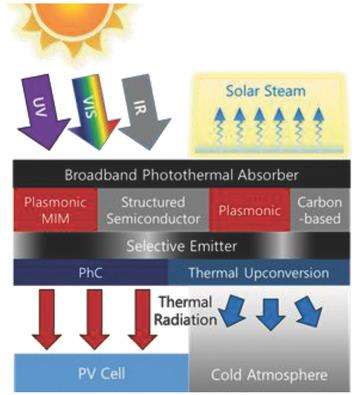当前位置:
X-MOL 学术
›
Adv. Opt. Mater.
›
论文详情
Our official English website, www.x-mol.net, welcomes your
feedback! (Note: you will need to create a separate account there.)
Thermoplasmonic and Photothermal Metamaterials for Solar Energy Applications
Advanced Optical Materials ( IF 8.0 ) Pub Date : 2018-07-08 , DOI: 10.1002/adom.201800317 Dongheok Shin 1 , Gumin Kang 2 , Prince Gupta 1 , Saraswati Behera 1 , Hyungsuk Lee 1 , Augustine M. Urbas 3 , Wounjhang Park 4 , Kyoungsik Kim 1
Advanced Optical Materials ( IF 8.0 ) Pub Date : 2018-07-08 , DOI: 10.1002/adom.201800317 Dongheok Shin 1 , Gumin Kang 2 , Prince Gupta 1 , Saraswati Behera 1 , Hyungsuk Lee 1 , Augustine M. Urbas 3 , Wounjhang Park 4 , Kyoungsik Kim 1
Affiliation

|
Sunlight is one of the Earth's clean and sustainable natural energy resources, and extensive studies are conducted on the conversion of solar energy into electricity using photovoltaic (PV) devices. However, single‐junction PV devices cannot break the theoretical efficiency limit known as the Shockley–Queisser limit that is caused by the sub‐bandgap transmission and heat dissipation losses in semiconductors. Solar thermal conversion approaches may provide an alternative way to exceed this limit and enable more efficient use of solar light than that in PV devices. Recently, spectrally or thermally engineered metamaterials have attracted considerable attention for solar energy applications because of their excellent physical properties. The recent research progress in the development of these photothermal and thermoplasmonic metamaterials, along with their promising applications in solar thermophotovoltaics, radiative cooling, and solar desalination, is discussed.
中文翻译:

用于太阳能的热等离子体和光热超材料
阳光是地球上清洁和可持续的自然能源之一,并且进行了广泛的研究,研究如何使用光伏(PV)设备将太阳能转换为电能。但是,单结光伏器件不能突破理论上的效率极限(称为Shockley-Queisser极限),该极限是由半导体的子带隙传输和散热损失引起的。太阳能热转换方法可以提供一种超出此限制的替代方法,并且可以比PV设备更有效地利用太阳能。最近,光谱或热工程超材料由于其优异的物理性能而在太阳能应用中引起了相当大的关注。这些光热和热等离子体超材料的最新研究进展,
更新日期:2018-07-08
中文翻译:

用于太阳能的热等离子体和光热超材料
阳光是地球上清洁和可持续的自然能源之一,并且进行了广泛的研究,研究如何使用光伏(PV)设备将太阳能转换为电能。但是,单结光伏器件不能突破理论上的效率极限(称为Shockley-Queisser极限),该极限是由半导体的子带隙传输和散热损失引起的。太阳能热转换方法可以提供一种超出此限制的替代方法,并且可以比PV设备更有效地利用太阳能。最近,光谱或热工程超材料由于其优异的物理性能而在太阳能应用中引起了相当大的关注。这些光热和热等离子体超材料的最新研究进展,











































 京公网安备 11010802027423号
京公网安备 11010802027423号